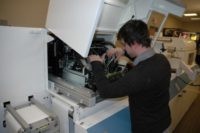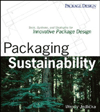Printing: Flexo
Sourcing Sustainability: Green Equipment Upgrades for Flexo Printing






The packaging industry, like much of the world around us, is making strides to become more sustainable and environmentally friendly. The flexographic printing market is not exempt from these trends and, as printers begin to feel pressure from customers to become more sustainable, it is important to consider how and where to implement these changes.
At the core of any flexographic printing company, a facility’s presses and equipment are not only key to your organization’s success, but also a means to achieve your sustainability goals. So, what technological advancements can flexographic printers incorporate to make their operations more energy efficient while also positively impacting their bottom line? Here’s a look:
Reducing Waste by Enhancing Quality
We expect to see smart facilities and artificial intelligence (AI) continue to pave the way for sustainability and green efforts in flexible packaging. The latest generation of flexographic equipment is following suit with integrated AI features, which have created machines capable of more consistent printing with less variability. This allows products to be brought to quality specifications at rapid speeds while also producing less physical waste, which benefits an organization’s green efforts.
Think about what is arguably the most important piece of any flexographic operation: the printing presses. AI technology, such as camera-based automatic impression and register systems, takes operator error and guesswork out of the equation as presses adjust to address print inaccuracies without human intervention. Similarly, recent anti-bounce innovations utilize algorithms to monitor, adjust and address bounce in real time, helping to reduce both run times and unnecessary waste.
In addition, printers should look beyond the presses and explore how they can reduce waste during the pre- and post-print process. For example, consider your anilox cleaner. Most cleaners utilize water and harsh chemicals that require special disposal protocol. By integrating technology such as laser anilox cleaners into facilities, printers eliminate the need for chemicals or detergents and the resulting waste. At the same time, this innovation also enhances color density, advances print speeds and improves the quality of the final product, all of which positively impact your bottom line.
Also worth considering are existing equipment add-ons, such as bridge sleeves, that are readily available, offer cost-effective solutions when producing larger outputs and reduce vibration and bounce. In turn, these sleeves improve the consistency and accuracy, cut run times and reduce the amount of product lost due to poor quality.
Saving Energy (and Money) in a Flexo Facility
Advanced technology in flexographic facilities is key to not only reducing waste, but also reducing the amount of energy used. Newer presses feature regenerative drives that allow printers to utilize the equipment’s own inertia to regenerate energy for a later time. As you slow down and stop a machine, that energy is absorbed, stored in capacitators and used when the machine returns to the motoring phase. This means that once a piece of machinery is up and running, it is essentially running on free, preserved energy.
Other recent innovations, like compressed air dryers, which are powered by electricity rather than natural gas, have enabled printers to utilize alternative forms of energy, such as solar power. Compressed air offers another benefit that forced air cannot: heat as a byproduct. As the dryer releases the air, it simultaneously produces hundreds of degrees of additional energy needed for the drying process, creating a more cost-effective and energy-efficient solution.
Taking a Step in a Sustainable Direction
With so many options, it can be overwhelming to consider where to begin. We recommend facility managers review the waste streams within the plant and follow them back to the sources. What areas of your operation are producing the most waste? Which equipment is utilizing the most energy? By locating the source, you can identify key areas to implement changes.
Flexographic printers should also consider the sustainability efforts their customers are currently implementing and work to proactively integrate the proper machinery into their facilities. As customers begin to adopt films composed of recycled scrap materials or lower gauge films that reduce the amount of plastic used, it becomes that much more critical that machinery is manufactured to exact tolerances. As the material becomes thinner, it becomes more difficult to convert, which requires precision machinery to prevent waste.
Presses and machinery are major investments that printers expect to last for years, if not decades, and upgrading for the sole purpose of enhancing sustainability may not seem realistic. There are options, however, that have significantly smaller price tags and still take a step in the “green” direction.
Work with your equipment manufacturer to identify pieces of machinery that can be upgraded through retrofitted components and controls. Facilities can also kick-start their sustainability initiatives without blowing the budget by upgrading smaller pieces of equipment, such as dryers and anilox cleaners, rather than presses.
The Flexible Packaging Association (FPA) estimates the global flexible packaging industry was valued at more than $86 billion in 2018. As this market shows few signs of slowing down, key players within the CPG sector will continue to request and favor green suppliers and partners. Flexographic printers need to adopt sustainability initiatives and use these efforts as differentiators to lead the charge, or they’ll end up laggards. Changing the mentality within the industry will not be easy, but those that do will reap the rewards.
Paper Converting Machine Company (PCMC)
Looking for a reprint of this article?
From high-res PDFs to custom plaques, order your copy today!











